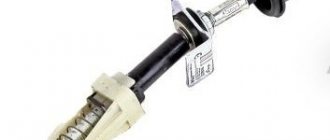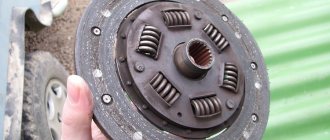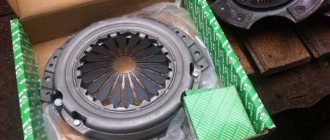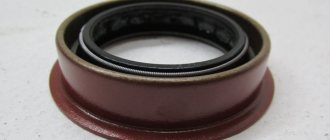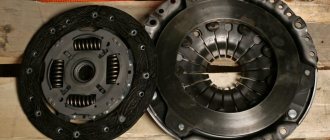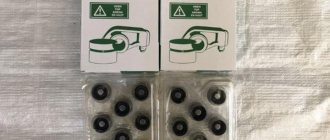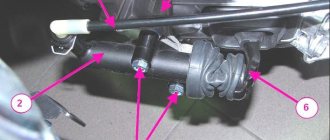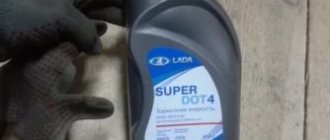The clutch has one, but very important, function - transmitting torque from the flywheel of the power unit to the input shaft of the speed box. The need for this process arises because the engine cannot be constantly connected to the transmission: the connection must be interrupted from time to time. This is exactly what the clutch does. The unit is quite reliable, but its wear and tear, like any other mechanism, cannot be avoided. What are the most common clutch malfunctions and how to identify them? To answer this question, you need to know what is included in this system and how it all works.
Principle of operation
There are quite a few varieties of the unit, so for a better understanding of its operation it is worth considering the functioning of the simplest dry single-disk version:
- First, the driver presses the desired pedal.
- The force is transmitted through a cable or rod of the main and then the working cylinder to the fork.
- It acts through the release bearing on the pressure plate petals, which bend towards the flywheel.
- As a result, the driven disk is disconnected from the flywheel of the internal combustion engine and the transmission is disconnected from the engine: the wheels stop rotating.
If you release the pedal, the connection between the motor and transmission will be restored. The more “gently” the driver releases the clutch pedal, the smoother the transmission is connected to the engine, which is especially important when pulling away.
Basic clutch malfunctions
Next, signs of breakdowns, causes and ways to solve problems with the clutch system (CC) working in conjunction with a manual gearbox (MT) will be discussed.
Incomplete clutch disengagement
In these cases, drivers say that the car is “driving.” In this case, the driven disk is not completely disconnected from the engine flywheel. As a result, the car moves away abruptly, and when changing gears the same thing happens, no matter how smoothly you press the clutch pedal.
Causes and solutions to the problem
- Lack of required pedal free play. This refers to the distance from its bottom to the floor. The data for each car brand is different, so you need to look for it in the appropriate sources and instructions.
- Incorrect adjustment of the CC shutdown drive. To solve this problem on cars with a mechanical clutch system (usually installed on front-wheel drive cars), it is enough to find the correct ratio of the two adjusting nuts. In a car with a hydraulic drive, adjust the stroke of the CC fork by adjusting the stroke of the working cylinder rod.
- Warping of the driven disk. If the mechanical runout exceeds 0.5 mm, the lining begins to warp and finds itself almost constantly pressed against the flywheel.
- Jamming of the driven disk hub (misalignment) on the splines of the gearbox input shaft. The problem can be solved by cleaning and lubricating them like LSC15. Typically, such a problem occurs on a car that has not been in use for a long time and has been parked in the open air. If the above steps do not help, you will have to replace the disk or input shaft.
The clutch is slipping
You press the gas, the engine roars, and the car (especially uphill) drives reluctantly and accelerates slowly. Another symptom: there is a burning smell in the cabin.
Reasons and methods of repair
- Incorrect clutch pedal free play adjustment.
- Contact of lubricant on the friction lining of the driven disk. This is typical for old cars, in which oil leaks out in “unknown” ways due to loose connections, bad seals, and when driving it splashes under the bottom, reaching the lining. As a result, we get a burning smell. To fix the problem, find the source of the lubricant leak and wipe the disc.
- Friction lining wear. There are two options: replace this element (which is what they did in Soviet times and the 90s) or buy a new driven disk, which is preferable, since riveting the lining correctly is not at all as easy as it seems: if done incorrectly, you will again have to dismantle the manual transmission and, in the end, still buy a new disk.
- Drive failure. Inspect the CC fork, cable (for vehicles with a mechanical system) and make sure the working cylinder is working (for vehicles with hydraulics). To do this, place the car on the inspection hole and ask an assistant to press the clutch pedal several times: From below you should see how the working cylinder rod pushes the fork.
- In vehicles with a hydraulic drive, the cause of clutch slip may lie in the master cylinder, where the compensation hole may be clogged. The device must be removed and washed.
Acceleration
A clear sign of clutch wear is when the vehicle accelerates. If the car does not accelerate in proportion to pressing the throttle, that is, the engine begins to oil, but the car does not move, especially uphill, then this is exactly one of the following reasons:
- The clutch drive is poorly adjusted (the cable is too tight or the hydraulic cylinder rod is too protruded, depending on the type of drive)
- Clutch disc wear
- Oil got on the clutch
- Someone pushed hard from the start and burned the disk. One start is enough to get a good burn.
So, the clutch drive is tightened for a reason, mainly when the basket is already tired and does not work within factory limits, that is, it has lost a little rigidity and in order for it to move away from the disc when pressed, you have to press deeper on it. Definitely a replacement. Another reason may be a cable with less rigidity than necessary; it stretches more than it should and does not press much. In order for it to work at least somehow, it has to be clamped more than required. We need to check, otherwise the basket will turn out to be working, I had this happen.
When the friction linings of the clutch disc wear out, the friction between the basket and the flywheel disappears. The same thing happens when oil gets on the disk - a common situation when the rear oil seal of the engine leaks. Here you need to remove the box and change the oil seal, because it won’t work like that. At the same time, you can change the disk, you can leave the basket, and look at the situation.
Worn “slightly burnt” clutch
But the clutch disc also becomes unusable if you press too hard at the start (street racers, hello!), the disc burns out immediately and loses its frictional properties, with the bonus of a burnt smell.
In general, if it smells burnt when driving, then this clutch stinks, especially when it is not pressed in enough and the disc is rubbing.
Why the clutch may break prematurely
The resource of this unit is quite large and averages 100-150 thousand km (depending on the car brand and operating conditions). But what leads to its reduction? There are not many factors:
- aggressive driving: throwing the pedal and constant sharp pressing on it quickly wears out the friction linings;
- constant movement with maximum load: especially typical for commercial vehicles (such as Gazelle, Ford Transit, etc.);
- improper towing of another car: if its weight significantly exceeds the weight of your car, there is a risk of burning the clutch: if you smell a burning smell, stop immediately;
- frequent and inept use of the clutch: for example, holding the pedal half-pressed when there is no need for it.
Where is it used?
Automakers use this element on systems with two disks - slave and master. The first element receives torque from the second and transmits it to the transmission. Further, through the cardan transmission, the force is transmitted to the gearbox, and then to the wheels. The drive disc is tightly secured to the crankshaft. In order for the driver to move from one gear to another (no matter whether it is high or low), it is necessary to separate these two elements. This operation is carried out precisely thanks to the bearing. The force is controlled by pressing the clutch pedal. When it is pressed to the floor, the transmission of torque stops - the bearing rotates at the same speed as the flywheel. As it is released, the two disks are connected to each other. At this time, high loads are observed on the clutch release bearing. Malfunctions of these elements arise precisely because of heavy loads.
Replacing the VAZ 2109 clutch.
The mass-produced VAZ 2109 clutch has a load reserve of approximately 50 percent. Therefore, when the engine is forced, it simply cannot withstand the increasing loads and begins to “slip” and break. This problem can be solved by replacing the clutch.
At the same time, the new clutch must correspond to the existing loads, have the necessary margin of safety, and also transmit the engine torque to the input shaft and to the wheels. After all, when the clutch begins to slip, it constantly heats up, which begins the process of its destruction. Which is unacceptable, because this component of the car plays one of the key roles in the design of the latter. That is why the car owner should pay increased attention to the technical condition of the clutch.
How to determine its wear?
First of all, the element will begin to make characteristic noises and sounds. And what’s most interesting is that they are impossible to notice while driving in gear. But as soon as you press the clutch pedal, a terrible hum occurs, and sometimes a knocking sound. It is especially intensified in winter. It is worth noting the high reliability of the design of such a part as the clutch release bearing. It is very difficult to notice signs of a malfunction of this unit in the early stages. Sometimes a slight rustling will be heard, which does not intensify over time. However, this sign is quite enough to diagnose the element for malfunction. Difficulties also arise when engaging gears, especially reverse. Turning on the speed may be accompanied by a characteristic crunching sound. Also, this symptom may indicate a malfunction of the synchronizers or the pressure and driven disk. But in any case, when noise appears, it is necessary to diagnose all components of the assembly.
Electronic gas pedal
In cars with this system, a sensor is attached to the clutch pedal, which informs the control unit about its position. It improves the control process by eliminating “dips” in engine speed and jerks when changing gears. When you press and release the clutch pedal, the control unit regulates the speed and adjusts the ignition timing. This also has a positive effect on fuel consumption.
Clutch pedal sensor
A malfunction of this sensor leads to the car “jerking” when changing gears, the revolutions begin to fluctuate when the clutch is disengaged, and fuel consumption increases. A malfunction indicated by the Check Engine light on the dashboard.
The reason for this is:
- sensor failure;
- short circuit or open circuit;
- misalignment of the clutch pedal.
But what can we do?
Everything is very simple. For example, you arrived at an intersection where the traffic light was red. If the green light does not light up within 5-10 seconds, feel free to turn on neutral, and keep the car (if it is a slope) on the handbrake or brake pedal. Fortunately, many traffic lights have a timer, so you can predict the situation in advance. But this rule must be used not only at intersections, but also in any other traffic situation (for example, while standing in a traffic jam). You should not “play” with the clutch, sneaking behind an oncoming car in order to maintain a minimum distance.
ABOUT THE DEVICE AND PRINCIPLE OF OPERATION
It is a regular roller bearing of a specific design.
In the clutch mechanism, it is destined to serve as a stop for transmitting the forces that will come from the pressed pedal. The bearing then transmits this movement to the pressure plate to break the connection between the basket and the flywheel. Without this, it is impossible to turn on the speed and start moving. Its structure can also be judged from the photograph.
Release bearing disassembled
From the photo you can see that it consists of three main parts:
- Clip with guide bushing;
- Roller bearing;
- Fixing washer.
ABOUT THE SIGNS OF MALFUNCTION AND THE REASONS FOR THEIR APPEARANCE
The main sign that the release bearing has failed is knocking and whistling when the engine is running, when you try to turn on the speed.
If such a sound appears in winter, this does not always mean that the VAZ 2114 clutch release bearing has failed. The release body is made of high-quality steel, which is resistant to temperature changes and has a low coefficient of thermal expansion. The guide bushing is made of ordinary steel, so it will respond to temperature changes. But if the noises, knocks, and whistles continue to intensify, it is necessary to repair or replace it.
Examination
To make sure that the clutch really needs to be replaced with a clutch releaser on a VAZ 2114, it is first recommended to check it thoroughly for malfunctions. This will allow you to determine whether this device is really the cause of the problem.
The bearing allows the disc to disengage from the basket, plus it additionally ensures that the clutch is engaged and disengaged.
There are two types of squeezers:
- Roller. They work on the basis of a rigid bunch of rods.
- Hydraulic. The hydraulic system ensures power transmission.
Even an inexperienced car owner can detect a faulty release bearing. The failure of this element manifests itself as follows:
- When moving, extraneous sounds and noises arise;
- Gear shifting is difficult;
- When overtaking, the clutch may completely disappear;
- Slippage occurs during acceleration, etc.
If the squeezer turns out to be truly faulty, it is the responsibility of every car owner to replace it immediately. This can be done with the help of service station technicians, or with your own hands.
HOW TO CHANGE A BEARING
While driving, you can hear something in the box humming loudly. The gears are switched on with great difficulty and noise. This means only one thing: an urgent replacement of the release bearing of the VAZ 2114 is necessary. I would like to immediately note that there are no special problems with the replacement. If you wish, you can do it yourself. Let's look at how you can replace it yourself.
HOW TO CHOOSE IT
When choosing a new spare part, you should inquire about the manufacturer of this product and whether it has a quality certificate. The presence of counterfeits in retail chains can long-term cause distrust in serious companies producing reliable spare parts.
You can be offered products from such companies as UBP, AvtoVAZ, DK, SB3 TA, LSA. The cost can range from 200 to 800 rubles. About which bearing is better for the VAZ 2114, it is better to consult with those who have already changed it on their car, or with service center specialists.
PROCEDURE FOR PERFORMANCE OF REPLACEMENT WORK
It is best to replace the “releaser” in an inspection hole in the garage, or on a lift. But due to the fact that not every garage cooperative has a lift, we will change the “releaser” in the pit. To do this, you need to remove the gearbox from the engine.
We will not consider the process of removing the gearbox now. It is described in great detail in various sources. To replace the “releaser”, prepare the following tools:
- Flat screwdriver;
- Set of wrenches;
- CV joint grease-4.
CV joint grease-4
You can use Litol-24 or other similar lubricants. The replacement process occurs as follows:
- We will assume that the box has already been removed. Therefore, it is necessary to disengage the clutches on the bearing.
- Next, you have to remove the bearing from the guide along with the coupling;
- Wring out the tabs (four pieces) of the spring holder and remove it;
- Now you can remove the bearing from the coupling;
- All removed parts are carefully inspected and, if necessary, replaced with new spare parts;
- Before installing a new bearing, it must be thoroughly checked. It should rotate slightly and not have even a slight play.
- If the check has confirmed the reliability of the bearing, it can be installed in its place;
- A layer of lubricant is applied to the surface of the guide bushing;
- Install the bearing and secure it with clamps.
After this, you can begin installing the gearbox. After installing all clutch and transmission elements in their places, it is necessary to check the functionality of the clutch drive. If necessary, then adjust it.
If there is even the slightest doubt about the possibility of replacing the release valve yourself, it is better to contact a service point. The cost of replacement at a car service is approximately 3000-3500 rubles, with guarantees for the work performed.
Vibration
A faulty clutch can cause vibration, this is not surprising, because the assembly undergoes a rotational movement and imbalance causes vibration.
It happens that after replacing the clutch with a new one, vibration appears. It would seem that everything seems to be new, but when starting off there is some kind of vibration and jerking. Most likely, you came across a restored basket, the so-called refurbished, that is, the clutch is changed at a car service center, the old set is sent to the factory for restoration, and sometimes such imperfections happen. Such a set usually costs less than a new one, but it’s not a fact that they won’t push it on you under the guise of a new one. The box should say refurbished
.
On an old, battered clutch, if when starting off, the damper springs have become loose, or the basket begins to fall apart; if vibration occurs while driving, the basket is most likely torn; a slight vibration may indicate slight wear of the basket, especially if only the disk was replaced at the last time. In general, the clutch is a part that must be dynamically balanced; if the center of mass is suddenly disturbed, then in any case vibration will result at certain engine speeds. The flywheel will not give such a vibration for no reason, it just comes off and punches everything in its path if it is not screwed on properly.


